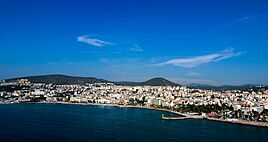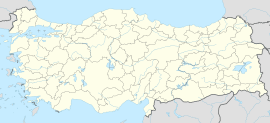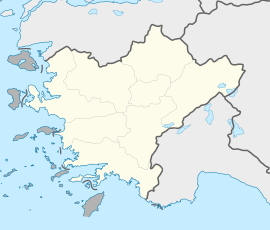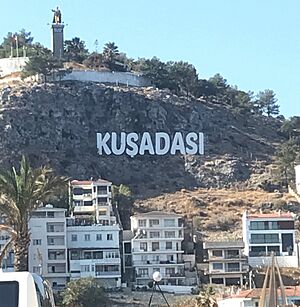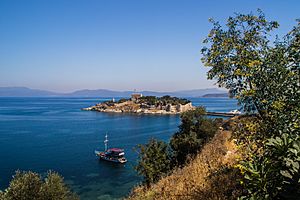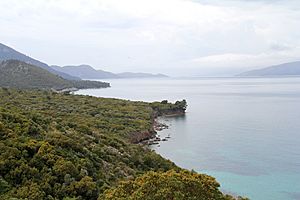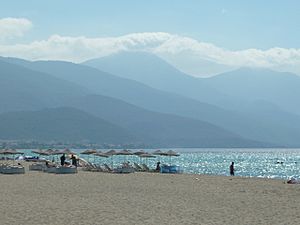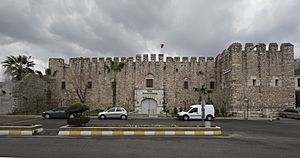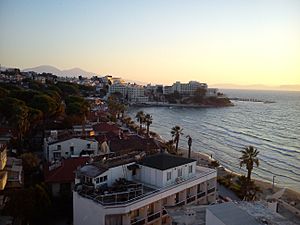Kuşadası facts for kids
Quick facts for kids
Kuşadası
|
||
|---|---|---|
|
Settlement
|
||
|
Wide-angle view of Kuşadası downtown
Statue of Mustafa Kemal Atatürk in the centre
The shoreline with the Pigeons in Hand statue
Dilek Peninsula-Büyük Menderes Delta National Park
A forest area by the sea on the Dilek Peninsula
|
||
|
||
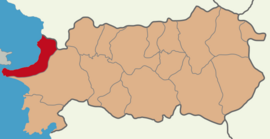
Map showing Kuşadası District in Aydın Province
|
||
| Country | Turkey | |
| Province | Aydın | |
| Area | 265 km2 (102 sq mi) | |
| Population
(2022)
|
130,835 | |
| • Density | 493.7/km2 (1,278.7/sq mi) | |
| Time zone | TRT (UTC+3) | |
| Postal code |
09400
|
|
| Area code | 0256 | |
Kuşadası is a city and district located in Aydın Province, Turkey. It covers an area of 265 square kilometers and had a population of 130,835 people in 2022. This large resort town is found on the Aegean coast. Kuşadası is about 95 kilometers south of İzmir and around 60 kilometers west of Aydın. The main business in Kuşadası is tourism. The current mayor of the district is Ömer Günel.
Contents
- What Does Kuşadası Mean?
- A Look Back: Kuşadası's History
- Kuşadası's Location and Surroundings
- Who Lives in Kuşadası?
- Kuşadası's Economy: Tourism is Key
- Getting Around Kuşadası
- Fun Places to Visit in Kuşadası
- Culture and Festivals in Kuşadası
- Sports in Kuşadası
- Kuşadası's International Connections
- See also
What Does Kuşadası Mean?
The name Kuşadası comes from two Turkish words: kuş (meaning bird) and ada (meaning island). This is because the island near the city looks like a bird's head when seen from the sea.
In the past, during the Byzantine times, it was called Ephesus Neopolis. Later, under the Genoese and Venetians, it was known as Scala Nova or Scala Nuova, which means "New Port." The name Kuş Adası was officially adopted during the Ottoman period in the early 1900s. Today, many people in Kuşadası simply call their town Ada.
A Look Back: Kuşadası's History
Ancient Times: Early Settlements
The area where Kuşadası is located has been a hub of art and culture for a very long time. People have lived here since about 3000 BC, starting with the Leleges people. Later, the Aeolians arrived in the 11th century BC, followed by the Ionians in the 9th century BC.
Early sailors and traders built many small towns along the coast, including one called Neopolis. This area was once an outpost of Ephesus, a famous ancient city in Ionia. Kuşadası was a smaller port used by ships trading along the Aegean coast. It became more important when Ephesus's harbor filled up with silt, making it unusable.
From the 7th century BC, the Lydians ruled the coast. Then, in 546 BC, the Persians took control. By 334 BC, Alexander the Great conquered all of Anatolia, including this coast. After that, the coastal cities became important centers for Hellenistic culture.
Roman Rule and the Rise of Christianity
The Roman Empire took over the coast in the 2nd century BC. They made it a provincial capital during the early years of Christianity. It is believed that Saint John the Evangelist and the Virgin Mary both lived in this area. During the Christian era, the region became known as "Ania."
As traders from Byzantine, Venice, and Genoa began to trade along the coast, the port was rebuilt. It was renamed Scala Nova or Scala Nuova, meaning "New Port." A military base was set up on the island, and the town center moved from the hills to the coast.
The Ottoman Era and Modern Turkey
In 1834, the castle and military base on the island were rebuilt and made larger. This island became so important that people started calling the entire town Kuşadası, or "bird island."
However, in the 19th century, trade in Kuşadası slowed down. This was because a new railway from İzmir to Aydın was built, which bypassed Kuşadası.
During the Turkish War of Independence, Kuşadası was occupied by Italian troops from 1919 to 1922, and then briefly by Greek troops. Turkish forces, led by Mustafa Kemal Atatürk, finally took control of the city on September 7, 1922.
After the Turkish Republic was formed, there was a population exchange in 1923. The Greek people living in Kuşadası moved to Greece, and Turkish people moved to Kuşadası. Kuşadası was part of İzmir Province until 1957, when it became part of Aydın Province.
Kuşadası's Location and Surroundings
The city is located along a gulf in the Aegean Sea. Güvercinada (Pigeon Island) is connected to the mainland by a short road. It sits next to the large hill of Kese Dağı, close to the city center.
Kuşadası is about 95 kilometers south of İzmir, which is the main city in the region. It's also about 60-70 kilometers from Aydın, the provincial capital. Its neighbors include Selçuk to the north, Germencik to the northeast, and Söke to the east and south.
Local Neighborhoods
Kuşadası District has 23 neighborhoods, which are called mahalle in Turkish. These include:
- Alacamescit
- Bayraklıdede
- Caferli
- Camiatik
- Camikebir
- Çınarköy
- Cumhuriyet
- Dağ
- Davutlar
- Değirmendere
- Ege
- Güzelçamlı
- Hacıfeyzullah
- İkiçeşmelik
- Kadıkalesi
- Kadınlardenizi
- Karaova
- Kirazlı
- Soğucak
- Türkmen
- Yavansu
- Yaylaköy
- Yeniköy
Kuşadası's Weather
Kuşadası has a hot-summer Mediterranean climate. This means it has very hot and dry summers, and mild, rainy winters.
| Climate data for Kuşadası (1991–2020) | |||||||||||||
|---|---|---|---|---|---|---|---|---|---|---|---|---|---|
| Month | Jan | Feb | Mar | Apr | May | Jun | Jul | Aug | Sep | Oct | Nov | Dec | Year |
| Mean daily maximum °C (°F) | 13.7 (56.7) |
14.7 (58.5) |
17.3 (63.1) |
20.6 (69.1) |
24.8 (76.6) |
29.4 (84.9) |
31.8 (89.2) |
31.6 (88.9) |
28.2 (82.8) |
24.1 (75.4) |
19.4 (66.9) |
15.1 (59.2) |
22.6 (72.7) |
| Daily mean °C (°F) | 9.6 (49.3) |
10.4 (50.7) |
12.7 (54.9) |
15.9 (60.6) |
20.0 (68.0) |
24.5 (76.1) |
26.8 (80.2) |
26.7 (80.1) |
23.3 (73.9) |
19.3 (66.7) |
14.7 (58.5) |
11.1 (52.0) |
18.0 (64.4) |
| Mean daily minimum °C (°F) | 6.1 (43.0) |
6.7 (44.1) |
8.5 (47.3) |
11.6 (52.9) |
15.6 (60.1) |
19.9 (67.8) |
22.1 (71.8) |
22.3 (72.1) |
18.8 (65.8) |
15.0 (59.0) |
10.9 (51.6) |
7.8 (46.0) |
13.8 (56.8) |
| Average precipitation mm (inches) | 117.99 (4.65) |
97.02 (3.82) |
72.56 (2.86) |
44 (1.7) |
27.99 (1.10) |
5.37 (0.21) |
0.85 (0.03) |
0.08 (0.00) |
21.87 (0.86) |
42.86 (1.69) |
95.69 (3.77) |
115.58 (4.55) |
641.86 (25.27) |
| Average precipitation days (≥ 1.0 mm) | 8.8 | 8 | 6.8 | 4.7 | 3.6 | 1.4 | 1.3 | 1 | 2.1 | 3.9 | 6.2 | 9.6 | 57.4 |
| Average relative humidity (%) | 63.2 | 62.8 | 61.2 | 61.6 | 61.7 | 56.8 | 55.5 | 58.8 | 60.7 | 64.4 | 64.2 | 64.7 | 61.3 |
| Mean monthly sunshine hours | 138.2 | 145.8 | 211.0 | 248.2 | 310.4 | 359.2 | 379.9 | 359.7 | 297.4 | 236.8 | 168.9 | 130.6 | 2,960.5 |
| Source: NOAA | |||||||||||||
Who Lives in Kuşadası?
In 2022, Kuşadası District had a population of 130,835 people living there all year. However, during the summer months, the actual population can grow to over half a million! This is because many tourists, both from Turkey and other countries, visit the city. Also, many people who work in hotels, restaurants, and construction come to Kuşadası for the busy summer season. There are also many foreigners who have chosen to live in the area permanently.
Kuşadası's Economy: Tourism is Key
Kuşadası is a popular spot for tourists who arrive by land or by cruise ship. Many cruise ship passengers stop here to visit nearby historical sites like Ephesus. In 2003, the city's port was updated to attract more luxury cruise ships.
The area is famous for its beautiful beaches. Some well-known ones include Ladies Beach, the beach in the city center, and the beaches near the Dilek Peninsula-Büyük Menderes Delta National Park. Locals often call the national park beach simply Milli Park.
Getting Around Kuşadası
You can get around Kuşadası and to nearby places using public minibuses called dolmuş. There are also buses and taxis that can take you to the airports in İzmir and Bodrum. You can also take day trips by boat from Kuşadası and Güzelçamlı.
Kuşadası is a port where many cruise ships stop. The port is connected to İzmir's Adnan Menderes Airport by a modern six-lane highway. Several state roads link the city to its surrounding districts, like Germencik and Aydın. You can also take daily ferry services to the nearby Greek island of Samos. The city's bus station is a major transport hub, with Coach buses connecting Kuşadası to many other parts of Turkey.
Fun Places to Visit in Kuşadası
- The City Walls: In the past, Kuşadası had three city gates, but only one remains today.
- Kaleiçi Mosque: This mosque was built in 1618 by a powerful leader named Öküz Kara Mehmed Pasha.
- The Öküz Mehmed Pasha Caravanserai: This historic building is located near the docks. It was built in 1618 to store goods for sailors.
- Güvercin Adası (Pigeon Island): This peninsula has a castle and lovely swimming beaches. There's also a cafe with great views of the harbor. Public beaches are on the other side of the peninsula.
- Kirazli: This is a traditional Turkish village about 12 kilometers from Kuşadası.
- Yılancı Burnu: This is another peninsula beyond Güvercin Ada. It might be where the first settlement of Neopolis was located. You can still see some old walls here, and there are beaches and beach clubs.
- Aqua-parks: There are several aqua-parks near the town with wave pools and exciting water slides.
- Ladies Beach: This beach is very close to the town center and is a major attraction for tourists.
- Kadıkalesi: This is a Venetian/Byzantine castle about 10 kilometers along the road from Kuşadası to Davutlar.
- Panionium: Located about 25 kilometers south of Kuşadası, this was once the main meeting place for the Ionian League. The ruins are not in great condition, and some people question if they are truly authentic.
- Dilek Peninsula-Büyük Menderes Delta National Park: This national park is about 30 kilometers south of the city center, next to the town of Güzelçamlı. It features beautiful coves, beaches, canyons, and even a cave. It's one of Turkey's most diverse and protected national parks.
Culture and Festivals in Kuşadası

- Kuşadası used to host an annual song contest, which was once won by the famous musician Cem Karaca.
- The annual Fanta Gençlik Festivali (Fanta Youth Festival) travels around Turkey, holding concerts in different cities. In 2010, Kuşadası hosted one of these concerts.
- The Kuşadası Gençlik Festivali (Kuşadası Youth Festival) has been held every year since 2016 at Sevgi Plajı (Love Beach). This beach is about 17 kilometers south of central Kuşadası, near the Davutlar area. The festival lasts five days in July and features over 30 artists. In 2017, about 90,000 people attended! It has become one of the most popular music festivals in Turkey.
Sports in Kuşadası
The local football teams, Kuşadasıspor and Kuşadası Yıldız Fenerspor, play their home matches at the Özer Türk Stadium. These teams compete in the Turkish Regional Amateur League.
Kuşadası's International Connections
Kuşadası has "twin town" or "sister city" relationships with several cities around the world. This means they share cultural and educational ties.
 Ludbreg, Croatia
Ludbreg, Croatia Bihać, Bosnia and Herzegovina
Bihać, Bosnia and Herzegovina Cherkasy, Ukraine
Cherkasy, Ukraine Uzhhorod, Ukraine
Uzhhorod, Ukraine Kyrenia, Cyprus
Kyrenia, Cyprus Marl, Germany
Marl, Germany Zenica, Bosnia and Herzegovina
Zenica, Bosnia and Herzegovina Târgu Mureș, Romania
Târgu Mureș, Romania Monterey, United States
Monterey, United States
See also
 In Spanish: Kuşadası para niños
In Spanish: Kuşadası para niños


